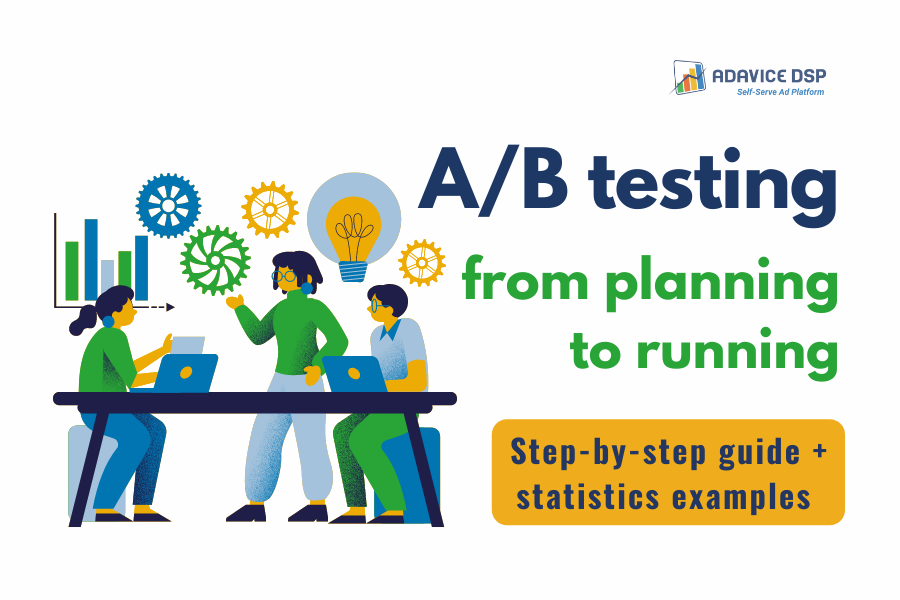

Level up your campaign optimization with A/B testing! Detailed guide from Adavice Team
Today we will talk about an essential skill for affiliate marketers that you can gain and improve. A/B testing, or split testing, is an optimization method of trying out different variables to check which performs best. It is used not only for the results’ evaluation but also for the improvement of the conversion flow.
This technique is popular in testing websites, email funnels, and other marketing tools. In affiliate marketing, the testing variables can be Landing pages, Prelanders, images, texts, or anything you can test in sets of more than one. After obtaining the results, an affiliate can optimize the campaign and continue running on the best-performing settings.
Mastering optimization will help boost your campaign’s effectiveness and increase the profitability indicators. A/B testing is much more than experimenting and we’ll prove it to you!

Any optimization method, including A/B testing, helps affiliate marketers to improve the campaign’s results by performing data-based analysis. Optimizing the campaign is extremely important as it helps to save time and money on the settings that don’t really suit the offer’s nature.
A/B testing is full of advantages as it is:
1) Data-proven y collecting testing results for a certain period
2) Insightful on user behavior and preferences
3) Helping to improve the user flow by eliminating the unfavorable elements
4) Raising profit by using the best-working settings’ combinations
A/B testing is the ultimate testing method in affiliate marketing. Both beginners and professionals widely use it to run their campaigns and improve performance through simple testing.
Just like before any optimization or changes in the campaign, we recommend planning out the testing period. And this is how you can do it!

Every great journey needs a roadmap! Before launching the tests, there are a few things an affiliate should keep in mind.
After reading all the offer’s requirements (GEO, device targeting, etc) make sure you are aware of the vertical’s market and your target audience. These factors are crucial to not feel left out of the current trends.
Check out more on verticals and target audience in Adavice Blog!
And now to the A/B testing. It requires a little more than setting the variables for test and analyzing the results later. Here is a list of steps to follow so you don’t miss anything:
1) Formulate the testing goal
Start by setting up the testing goal. It is connected to the type of tests you will be
making. Think of why are you running the test and what outcome you’d like to get.
Some goals examples may be: to identify the best-working push ad or boost the product’s
sales.
The aim can be split up into smaller ones.
The main thing here is to clearly understand what result you will get at the end of the
test.
2) Set the variables for the test
Choose what will be your test’s components. It is important to change 1 variable at a time
to obtain a clear difference in the results. Even a slight change may significantly
influence the click-through and conversion rates. The list of possible variables is
never-ending as it is up to your test’s goals:
- Images
- Ad texts
- Call-to-Action buttons
- Landings
- Prelanders
3) Decide on testing conditions
Make sure to pre-plan the testing from its duration to the future data size. The collected
statistics should be big enough to grasp the result and optimize based on it.
PRO TIP: Adavice experts recommend running the A/B tests for 2 days or X2 of your payout at least. For effective optimization, it is better to collect a sufficient amount of data.
4) Evaluate the success (metrics)
Get ready for the success evaluation. The KPI may vary according to your offer’s specifics.
Know the important metrics for your offer such as CTR (click-through rate), conversion rate,
amount of clicks, and conversions, cost per desired action. By determining these metrics
beforehand you’ll know what to look for in the statistics and improve your reactive
optimization.
Last but not least, you will have to set and run the A/B testing model.
Your freshly-made A/B testing funnel should look somewhat like this:

Let’s look at some A/B testing examples together and see how to correctly analyze the obtained results.
PRO TIP: It is essential to change 1 testing element (picture/text, etc) at a time to not mix the testing results.
A/B test: Creative ID
When testing creatives, you can check what pictures, texts, or emojis combinations work the
best. After the testing period, check your statistics to analyze the results:

In this example, you can see that the affiliate launched 4 creatives. From the received data creatives #1 and #4 have performed the best based on the lowest Costs per conversion ($0.33 and $0.14).
Solution:
1) Turn off creatives #2 and #3
2) Create copies of creatives #1 and #4 (differed slightly in texts or pictures)
3) Continue the A/B testing with the created copies
A/B test: OS
The OS A/B testing pattern is the same as that of the creatives. After the running period,
you’ll have to check the data, exclude the systems that don’t match your offer, and continue
running the best-converting ones.

The Androids 9, 10, 11, 12, and 13 were tested in the following campaign. Looking closer at the results of the OS testing, we can see the clear winners: Android 10 and 11 with the best Conversion rates and low Costs per conversion. Android 13 can be tested more as the CR is high and the Cost is not as high as of the best-performing ones. In comparison, OS with high Cost per conversion and 0% CR should be turned off.
Solution:
1) Include Android 10 and 11
2) Continue testing Android 13
3) Turn off Android 9 and 12
A/B test: Subscribers List ID (source)
Lastly, let’s take a look and the sources' statistics and use the same analysis technique.

Here is the data collected from 5 sources that were targeted in the campaign. As you can see most of the traffic ($55 spent) went into source #1234. Luckily, it converted the best with a relatively low CPA of $1.26. Out of the remaining 4 ones, only one source (#1111) didn’t bring conversions. It is better to turn it off and continue testing sources 2222, 2323, and 4312 as their CPAs and Costs are low.
Solution:
1) Keep targeting source #1234
2) Turn off source #1111
3) Keep testing sources #2222, 2323, and 4312
PRO TIP: Set up micro bidding for the best-converting creatives, OS, and sources and draw more traffic to them! Contact your Adavice Support manager to get more details.

As scary as it may sound, A/B testing is a powerful optimization method used by beginner and professional affiliate marketers. Practice makes perfect ;)
Have questions left? Contact us at sales@adavice.com, and share your ideas! Adavice Support Team is ready to help you set up your first campaign and start your affiliate journey 🙂
Rate this article